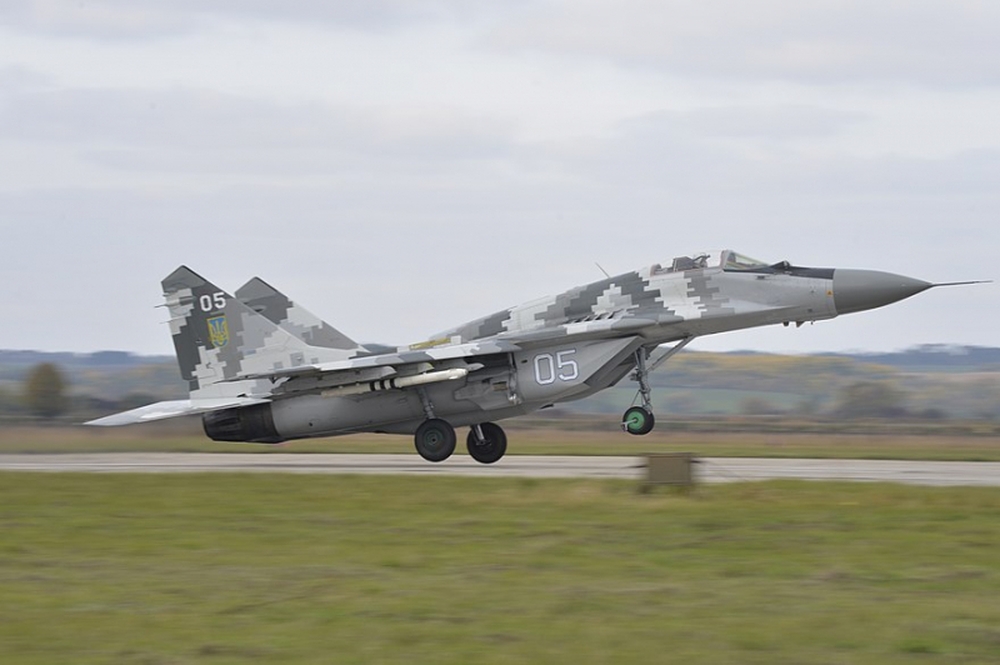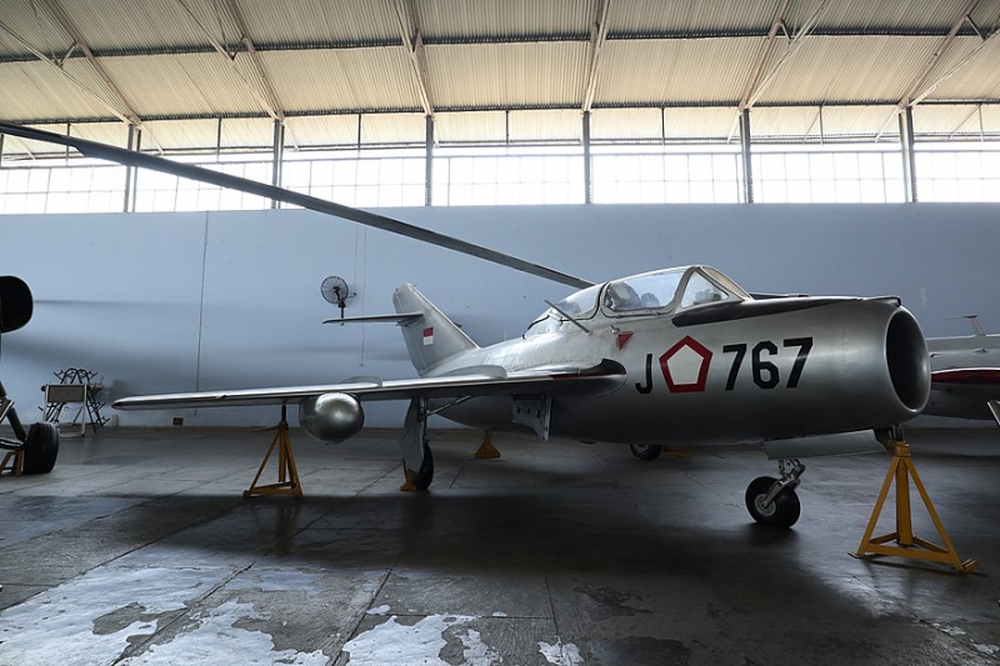The US Air Force, CIA, and other agencies have collected and analyzed intelligence on where they were made, how many MiGs were produced, production process, specifications, deployment, effects, etc. war, sales or shipping to each country.
Americans aspire to study MIG
In 1948, the Cold War was heated up when the Soviet Union began a blockade of West Berlin. The Soviet supply of MiG fighters to Eastern European forces further increased the threat they posed to US and allied air forces.
Then, the Cold War heated up in Korea when MiG-15 fighters flown by Soviet pilots to China to confront the US Air Force’s F-86 Saber fighters. In August 1950, RB-29 reconnaissance aircraft detected 122 MiG fighters in the sky over Northeast China.
According to a former CIA official, the United States had a lot of “communication intelligence” on MiG activity in Korea – although the conversion of communication frequencies from HF to VHF (between 1951-1952) caused The US Air Force security team struggled to establish an interception capability. This intelligence was obtained through combat radio intercept operations, in which the Russians used their mother tongue to expose the nationalities of the pilots.
The Americans also harbored ambitions to have their own MiG. In early 1951, the commander of allied air forces in Korea wanted a complete MiG-15, and the US forces were lucky enough to have one on the battlefield. In 1953, a North Korean pilot flew a MiG-15 straight to South Korea.
Aerodynamic testing of the MiG-15 has revealed its design prowess, but its engine technology and electronics lag far behind that of the United States. American spies also tracked MiG fighters in the Soviet Union and Eastern Europe. High-quality cameras mounted on the roof of the US embassy in Moscow photographed MiGs as they flew over the area near the Kremlin during air shows.
Beginning in July 1956, the United States used U-2 reconnaissance aircraft to photograph airfields and factories, and MiG fighters in vain intercepted the U-2. In October 1957, pilot Hervey S. Stockman returned to base with high definition photos of MiG bases on the Kola peninsula as well as MiG-19 fighters flying below the plane. These photos have shown the authenticity of the MiG fighter in stark contrast to the photos published by the Soviet Union.

The US-made KH-9 Hexagon image reconnaissance satellite, can take pictures over a large territory with extremely high resolution. Photo source: Air Force Museum.
American spies also collect human intelligence. In 1952, CIA sources reported on specifications seen in MiG-15 fighters in the (old) GDR. In April 1957, the CIA released a report that was a joint product of the US Air Force – CIA focusing on technical details for the MiG-15 and MiG-17 fighters of the Hungarian Air Force. .
Among the details are information on net weight, fuselage, wing structure, propulsion, electronics, tail warning radar, and weapons fitted to the MiG-17 fighter. A product of much gathering effort led to a CIA report in April 1954 regarding the construction of the MiG-15 at the Kuybyshev and Novosibirsk plant chains between 1950 and 1952.
U-2 reconnaissance aircraft continued to photograph MiG fighters around the world throughout the 1960s, from the MiG-21 at Santa Clara airport in Cuba on September 5, 1962, to A sortie in 1964 revealed 34 MiG-15s and MiG-17s at a newly built airfield at that time in Phuc Yen (Northern Vietnam).
By November 1965, the US had obtained the Soviet MiG 21F-13’s Manual of Pilot Techniques and Military Uses, which contained 265 pages of chapters on search and interception. , as well as air combat between MiG-21 fighters and enemy fighters, which ranged from range (from 3 to 6 miles) to close proximity probability using the aircraft’s R-3S missile.
By 1966, the United States had more than a manual when an Iraqi Air Force pilot flew a MiG-21 fighter to Israel. After being secretly tested in Israel, the aircraft was transferred to Groom Lake (Nevada, USA) where American experts flew it to determine some significant aerodynamic limitations.
In the following years, the CIA’s National Imaging Center (NPIC) mined images of MiG fighters provided by aerial sensors. In February 1966, NPIC again released a report on the situation of Phuc Yen (Vietnam) revealing that on December 23, 1965, 7 MiG-21 fighters and 4 canvas-covered aircraft were photographed. on the airport.
NPIC then also photographed MiG fighters flying back and forth between North Vietnam and China. The December 1966 report by NPIC reported that two MiG fighters were in flight, one armed with Atoll air-to-air missiles, while the other carried at least one UB-16-57 missile shell – a first for humans. The US knew that the MiG-21 in North Vietnam was equipped with missile casings. In addition, open sources and human resources also reveal the purchase and production of MiGs outside of the Soviet Union.
The CIA’s May 1965 report, titled “Soviet MiG-21 Plants in India: Progress and Prospects”, addressed the Soviet-Indian agreement, its location and functions. factories, construction plans, projected costs, and Indian plans to manufacture basic parts from raw materials…. American intelligence agencies continued to monitor the MiG-21 in Eastern Europe and the Soviet Union.
National intelligence estimates of the 1969 Warsaw Pact confirm that all-weather MiG-21 models account for more than 95% of the aircraft in Soviet air defense regiments, and that the MiG-21 built from 8 to 9 versions of which the latest version in the GDR had improved payload capabilities and improved air intercept radar.

Photo taken in 2018, a MiG-29 of the Ukrainian Air Force. Image source: Reader View of Wikipedia.
Intelligence analysis from weapon images
On its first mission, June 15, 1971, a Titan-3D rocket was launched into orbit, which was also the most sophisticated piece of reconnaissance hardware ever developed. The KH-9 (or Hexagon) image reconnaissance system with a resolution of 30cm to 60.9cm finally replaced the Corona satellite system when Americans wanted to search larger areas of overseas territory. , but specifically the Soviet Union.
Since its first launch in 1960, the Corona satellite has helped the US obtain the most accurate image of MiG fighters with intelligence on airfields, training areas, and deployment activities. However, the KH-9 is a significant improvement when it is capable of capturing many images over a vast territory with high resolution, according to a statement by former senior official Dino A. Brugioni (of NPIC).
Then in 1974, American intelligence provided the first suggestion that the MiG-23 fighter was purchased by the Syrian Air Force. A “cleaned” message dated April 4, 1974 from the CIA to the White House read: “The Soviet Union supplied the Syrians with MiG-23 fighters and trained Syrian pilots in combat.” .
Such reports were given with increasing frequency. In 1978, a Cuban refugee reported that a squadron of MiG fighters had arrived in Cuba, a claim confirmed by spy satellites. To clarify the truth, President Jimmy Carter ordered the resumption of the SR-71 mission in Cuba, which had been suspended since 1977. There are doubtful opinions that the MiGs have not only MiG-23 but also MiG-23. MiG-27 (ground attack version of MiG-23) that can be armed with nuclear weapons as well as the ability to penetrate deep into US territory.
However, aerial photography did not recognize the distinguishing features between the two types of aircraft, even taking pictures with the SR-71 strategic reconnaissance aircraft. American image interpreters reached out to a Cuban magazine when it published pictures of the MiG under investigation, and they asserted that it was indeed a MiG-23 fighter. In the late 1970s, the United States appreciated the MiG, an appreciation that could not be obtained from photographs.

Image of the first version of the MiG-15 fighter. Image source: Reader View of Wikipedia.
In 1977, the Constant Peg program (a continuation of the invasion squadron effort that began a decade in Nevada) was launched. Under these efforts, American pilots fought MiG-17, MiG-21 and MiG-23 fighters with some modest achievements.
The American pilots had a certain understanding of the MiG training activities conducted at the Tempelhof air station (West Berlin). Former Air Force Chief of Staff, General Merrill A. McPeak revealed: “From the very beginning, the MiG made an impression. But if fighting vertically, the MiG pilots are exhausted very quickly.”
In a presentation to the US Congress in 1984, General Lawrence A. Skantze (Deputy Chief of Staff of the US Air Force) described the capabilities of the MiG-29 Fulcrum fighter: “optimized attack capability, increased thrust-to-weight ratio, shot down, improved combat radius”.
In July 1984, Major General of the US Air Force, Michael V. Hayden (4-star general, CIA director) began a two-year tour as an air attache at the US Embassy in Sofia (Bulgaria).
More than two decades later, Mr. Hayden recalled intelligence gathering on MiG fighters when speaking to the US House Selective Intelligence Committee (SSIC):
“I try to take pictures of MiG-23s taking off from Bulgarian airports to understand what type of fighter they are.” In early 1982, a memo from the CIA’s deputy director of intelligence, Robert M. Gates, noted “the construction of several airfields in Nicaragua that have the potential to become bases for MiG fighters”.
By October 1984, American intelligence analysts had concluded that the MiG-21 might have been loaded onto the Soviet ship Bakuriani and headed somewhere in Central or South America.
An SR-71 reconnaissance aircraft sighted the Bakuriani in the Gulf of Mexico and made it clear that Cuba was not the destination. On November 7, 1984, the ship docked at the port of Corinto (Nicaragua), and soon after that, the SR-71 reconnaissance plane also hovered above the port. The Americans feared that the MiGs would fall into the hands of the Sandino National Liberation Front (Sandinistas for short).
On February 26, 1990, a short report from the US National Intelligence Council (NIC) said: “Mig-29s are in Cuba”, according to which Cuba has received at least 7 aircraft and will probably establish fleet of 12 aircraft.
On the other hand, the MiG-29 will enter actual combat in mid-1991, improving Cuba’s ability to threaten US surveillance flights.” The 1990s also saw new purchases of MiG-29s around the world. .
In the late 1990s, US Air Force intelligence obtained a complete version of the MiG-29. In October 1997, the US purchased 21 fighter jets from the Republic of Moldova, including MiG-29UB fighters.
Nearly two decades after the breakup of the Soviet Union, the need to gather intelligence on MiGs has not abated, Russia continues to produce and sell tweaked versions of MiGs. In 2007, Russia introduced the MiG-35. In March 2010, India agreed to buy 29 MiG-29 fighters for $2 billion.
at Blogtuan.info – Source: Soha.vn – Read the original article here



